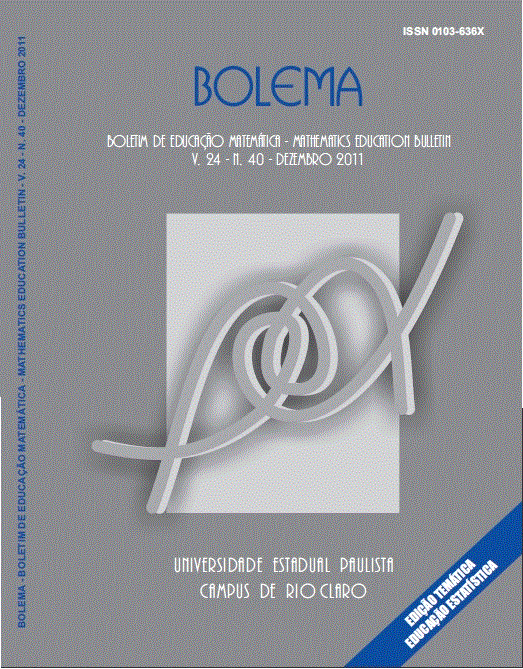<strong>O Uso de Simuladores e a Tecnologia no Ensino da Estocástica</strong>
Palavras-chave:
Ensino-aprendizagem. Educação Estatística. Ensino Fundamental. Tecnologia.Resumo
Resumo Esse artigo refere-se a parte de uma pesquisa de mestrado que teve por objetivo investigar as contribuições que a inserção da tecnologia pode trazer à educação estocástica. O termo “estocástica” tem sido utilizado para referir-se à inter-relação dos conceitos de combinatória, probabilidade e estatística. Embora o estudo tenha enfatizado os processos de ensino e aprendizagem de probabilidade e estatística, neste texto descrevemos as atividades relacionadas ao estudo probabilístico. A pesquisa realizada foi de natureza qualitativa, com análise interpretativa a partir de categorias emergentes da parte empírica: simulação, interação e resolução de problemas. O processo de análise convergiu para a elaboração de um estudo de caso sobre um grupo formado por quatro alunas, com as quais se desenvolveram as atividades e se investigou o seguinte problema: como os recursos tecnológicos podem ser úteis para a construção de novos conhecimentos da Estocástica no Ensino Fundamental? Para responder a essa questão, utilizou-se a perspectiva vygotskiana, considerando que, através de atividades de ensino, se possa promover a aprendizagem por meio da internalização. Dessa forma, o processo centrou-se na interação, com dimensão coletiva e com apoio de recursos tecnológicos. Tornou-se evidente que a inserção de tais recursos gera conhecimentos mais amplos e precisos, porém exige do professor um conhecimento teórico-metodológico muito mais aprofundado sobre o assunto. Além disso, os resultados destacaram a importância da simulação e do processo de interação na educação estocástica. Palavras-chave: Ensino-aprendizagem. Educação Estatística. Ensino Fundamental. Tecnologia. The Use of Simulation and Technology in Teaching Stochastic Abstract This paper describes part of a study that aimed to investigate the contributions that technology use can bring to stochastic education. The term stochastic has been used to refer to the interrelationship of the concepts of combinatorics, probability and statistics. Although the study emphasized the teaching and learning of probability and statistics, this text describes the activities related to the probabilistic study. The research was qualitative, with interpretive analysis based on categories that emerged from the empirical part: simulation, interaction and problem-solving. The analytic process converged with the preparation of a case study of a group of four students with whom the activities were developed, and the following problem was investigated: how can technology resources be useful for the construction of new knowledge about stochastic in the elementary school? To answer this question we used Vygotsky’s perspective, considering that learning activities can promote learning through internalization. Thus, the process focused on the interaction having the collective dimension and the support of technological resources. It became evident that the inclusion of these resources generates broader and accurate knowledge but requires a teacher with much deeper theoretical and methodological knowledge on the subject. Moreover, the results highlighted the importance of simulation and the process of interaction in stochastic education. Keywords: Teaching and Learning. Statistics Education. Middle School. Technology.
Downloads
Publicado
Edição
Seção
Licença

>>>>> BOLEMA: Mathematics Education Bulletin = BOLEMA: Boletim de Educação Matemática, Rio Claro, SP, Brasil - eISSN 1980-4415 - está licenciado sob Licença Creative Commons


